
How many different Japanese foods have you eaten? Have you ever ventured outside of the familiar Sushi and Rāmen?
Japanese cuisine features a variety of delicious dishes ranging from cheap, local foods to high-end meals. In Japan, you’ll find both authentic and traditional foods as well as foods that have evolved through the influence of other cultures.
Believe it or not, Tokyo is the world’s most Michelin-starred city—it’s not Paris or Rome, but the capital city of Japan! According to the Michelin Guide, 226 of its restaurants received stars for the thirteenth consecutive year. Japanese people are avid foodies and they’re quite picky when it comes to the taste of their food.
In this article, we’ll introduce a list of Japanese foods you must try. We’ll also give you some tips to help you enjoy Japanese food even more, an overview of unique Japanese dishes, food-related Japanese vocabulary, and a couple of easy Japanese recipes!
Ready to explore Japanese cuisine with JapanesePod101.com? Then let’s go!
 Table of Contents
Table of Contents
- Must-Try Japanese Food
- Authentic Japanese Food vs. Overseas Japanese Food
- Unique Japanese Foods
- Food-Related Japanese Vocabulary
- Easy and Simple Recipes
- How JapanesePod101 Can Help You Learn More Japanese
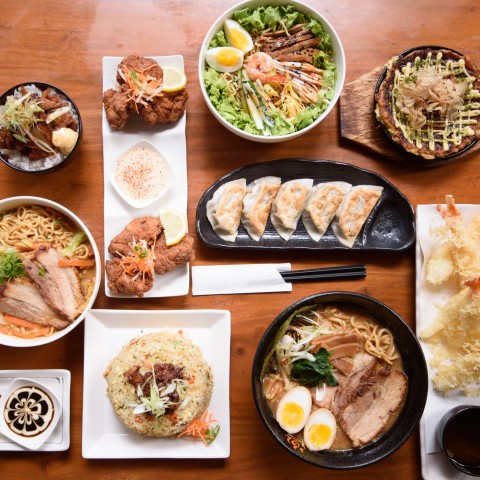
1. Must-Try Japanese Food
There are a few Japanese cuisine staples that everyone should try at least once. Exploring the flavors, ingredients, and presentation of these dishes will work wonders for your language studies by immersing you in the culture!
1 – 寿司 (Sushi)
Sushi is one of the most popular Japanese food items, both internationally and in Japan. In old times (before there were refrigerators), Sushi was originally a preserved food using pickled fish. In the Edo Period, fresh fish and shellfish were used on rice seasoned with vinegar; this is the same style of Sushi we have today.
As an island country surrounded by Mother Seas, Japan benefits from affluent fresh seafoods.
There are various types of Sushi, such as:
- にぎり(Nigiri) – “hand-formed”
- 軍艦 (Gunkan) – “warship-roll”
- 太巻き (Futomaki) – “thick-rolled”
- 細巻き (Hosomaki) – “thin-rolled”
- 手巻き (Temaki) – “hand-rolled”
- ちらし寿司 (Chirashizushi) – “(ingredients) scattered sushi”
In Japan, people can easily enjoy Sushi through takeout from casual Sushi restaurants or by purchasing it from supermarkets. There are also specialized Sushi restaurants for celebrations or special occasions.
There are several types of Sushi restaurants, ranging from budget Conveyor Belt Sushi / Sushi-Go-Round (回転寿司) restaurants to high-end restaurants that cost at least ¥20,000-¥30,000 (around $190-$280) per person. The price differences account for the quality and freshness of ingredients, how skilled the Sushi chef is, and the restaurant’s level of service and hospitality.

Authentic Japanese Sushi uses a variety of fish.
2 – ラーメン (Rāmen)
Originally imported from China, Japanese Rāmen evolved uniquely and became a very popular casual dish in Japan. Rāmen is inexpensive and you can find Rāmen restaurants, or ラーメン屋 (Rāmen’ya), throughout the country. Some Rāmen restaurants are very popular and have long lines to enter.
Rāmen is a bowl of soup noodles with various types of ingredients. There are several different soup flavors based on the ingredients used, such as:
- しょうゆ (Shōyu) – “soy sauce-flavored broth”
- とんこつ (Tonkotsu) – “creamy broth made of pork bones and vegetables”
- みそ (Miso) – “fermented soybean paste-flavored broth”
- しお (Shio) – “salt-flavored broth”
- 鶏白湯 (Toripaitan) – “creamy broth made of chicken bones and vegetables”
The soup is a very important element of Japanese Rāmen. It’s made with bones and vegetables, typically boiled for several hours or even for days, to extract flavors that have depth and richness. Every Rāmen restaurant has its own soup recipe, and some Rāmen restaurants are so popular that you have to wait in a long line to enter.
The 麺 (Men), or “noodle,” used in Rāmen is just as important as the soup. Each type of soup is matched with a certain type of noodle; the noodles can be thin, thick, straight, or curly. A good soup-noodle combination should have a good balance of stiffness, taste, and texture.
Rāmen is an easy and budget-friendly option when you’re traveling in Japan. Make sure you research which Rāmen restaurants are popular and have good local reviews in advance!

For Japanese Rāmen, the taste of the soup is very important and it takes several hours to make.
3 – カレーライス (Japanese Curry Rice)
Japanese curry is definitely one of the most popular Japanese foods! It’s usually cooked at home, but you can also find it in specialized curry restaurants called カレー屋 (karēya) or other restaurants. It’s typically a casual dish.
Originally from India, curry was introduced to Japan in the Meiji Era. Since then, its flavor and preparation/serving methods have developed to reflect Japanese food culture. Thus, the texture and flavor of Japanese curry is very different from those in Indian curry, Thai curry, or any other type of curry.
Japanese curry is served with white steamed rice and it’s commonly called カレーライス (karē raisu) or ライスカレー (raisu karē), both meaning “curry rice” in Japanese. Japanese curry typically uses a カレールー (karē rū), or “curry roux,” which is concentrated curry seasoning in block or powder form; it’s composed of curry powder, flour, oils, and other various flavorings.
Curry is cooked with various ingredients, typically meat and vegetables. One of the most popular curry recipes is カツカレー (Katsu karē), which is a perfect coupling of a Japanese pork cutlet and curry rice. There are a few other variations of Japanese curry, such as:
- スープカレー (sūpu karē) – “soup-style curry”
- カレーうどん (karē udon) – “curry-flavored udon noodle”
- カレードリア (karē doria) – “curry-flavored béchamelle on rice baked with cheese”

Katsu (pork cutlet) curry is one of the most popular recipes for Japanese curry rice.
4 – 天ぷら (Tempura)
Tempura is another one of the famous Japanese cuisine dishes you should try. It’s typically served at 和食 (wasyoku) Japanese restaurants or in specialized Tempura restaurants. You can have Tempura in casual, inexpensive restaurants as well as in high-class restaurants.
Tempura is made using a variety of ingredients, typically seasonal vegetables and seafood. The ingredients are lightly battered and delicately deep-fried, then served with 天つゆ (tentsuyu) dipping sauce and grated Japanese radish. It’s recommended to eat this dish while it’s still hot, immediately after frying, to enjoy the crispy texture.
Tempura is eaten as a main dish served with white rice and miso soup, though it’s also popularly served as 天丼 (Tendon), which is a Tempura bowl with salty-sweet soy sauce, or as a topping for noodle dishes such as うどん (Udon) and そば (Soba).

The main ingredients of Tempura are vegetables and seafood, especially prawns.
5 – しゃぶしゃぶ (Shabu-shabu)
Shabu-shabu is a Japanese hot pot dish with a variety of vegetables, tofu, and thin-sliced meat. It’s typically served at specialized Shabu-shabu restaurants and you’re expected to share a hot pot with at least one other person.
The hot pot, filled with だし (dashi) soup (seasoned broth), is placed in the middle of a table with a stove, and the ingredients are brought to the table raw. The fun part of this dish is to cook the ingredients yourself. Firstly, you put all vegetables into the pot to boil. While you wait for them to be boiled, you can pick up a very thin slice of meat with chopsticks and submerge it into the pot’s soup, swishing it back and forth for a few seconds as it quickly cooks. The name Shabu-shabu is the onomatopoeia of the swishing movement.
Once the vegetables and meat are cooked, you dip them in a citrus-based ポン酢 (ponzu) sauce or sesame sauce before eating them.
It’s most popular in the colder seasons of autumn and winter, as cooking and eating this delicious soup will warm you up.
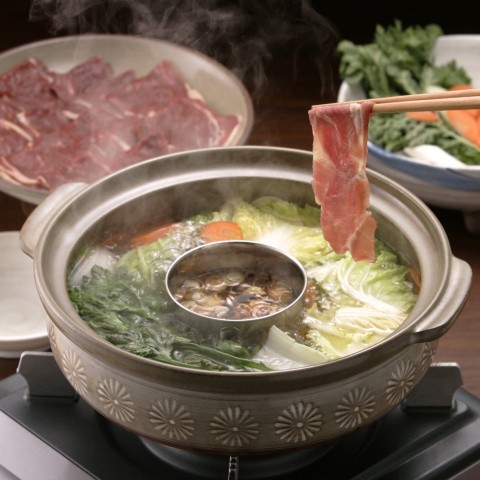
Ultra-thin meat boils quickly when it’s dipped and stirred in the hot pot.
6 – 丼ぶり (Donburi)
丼ぶり (Donburi), or “bowl,” dishes feature white rice on the bottom and other ingredients on top of the rice. Donburi dishes are also called 丼もの (donmono), or “bowl meals.”
There are various types of Donburi dishes and they’re available at casual budget restaurants as well as 和食 (washoku), or “Japanese food,” restaurants. Many people also cook these meals at home. There are two popular versions of this dish:
- 牛丼 (Gyūdon)
牛丼 (Gyūdon), meaning “beef bowl,” is one of the most popular bowls. The ingredients include thin-sliced beef, onions, and sometimes しらたき (shirataki) noodles topped with pickled ginger. The ingredients are simmered in a slightly sweet sauce seasoned with soy sauce, みりん (mirin) or “sweet rice wine,” and だし (dashi) or “fish stock.”
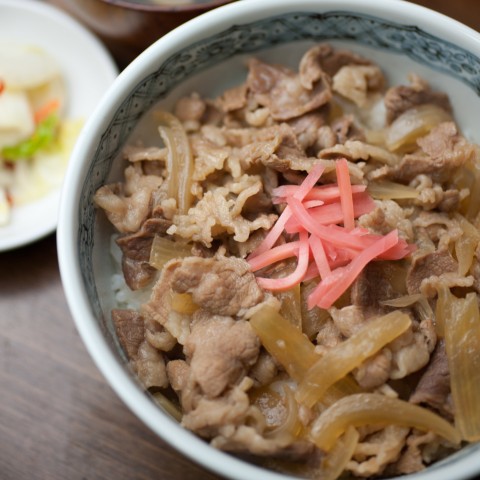
- カツ丼 (Katsudon)
Katsu means “pork cutlet.” This is a breaded deep-fried pork, also called とんかつ (tonkatsu).
Katsudon is prepared by simmering tonkatsu and onion with beaten eggs on rice. It’s then flavored with some soy sauce, みりん (mirin) or “sweet rice wine,” and だし (dashi) or “fish stock.”
There are some variations, such as the ソースカツ丼 (sōsu katsudon), or “sauced cutlet bowl.” Here, とんかつ (tonkatsu) is served on rice without simmering the onion and eggs, and it’s flavored with a tonkatsu sauce.

Katsudon is a rice bowl with a Japanese pork cutlet, usually boiled with egg (Photo by Hajime Nakano, under CC BY 2.0).
- 天丼 (Tendon)
Tendon is served with several Tempura on rice with salty-sweet soy sauce. Popular ingredients are prawn, eggplant, pumpkin, sweet potato, and squid.

Tendon is a Tempura bowl with sweet-salty soy sauce.
7 – 麺 (Men) – Traditional Japanese Noodles
There are many types of traditional Japanese noodles, and the ones on our list are the most popular in both restaurants and homes. Japanese noodle dishes are typically inexpensive.
- そば (Soba)
Soba is a traditional Japanese noodle made from buckwheat and wheat flour with water. The noodle is squared and typically around two millimeters in width. Soba is enjoyed hot in soups with toppings or cold with つゆ (tsuyu) dipping sauce.
- うどん (Udon)
Udon is another type of traditional noodle that’s made of white wheat flour and water. This thick and round noodle has a five- to six-millimeter width. Udon is also served hot or cold, in hot soups with toppings or with cold dipping sauce.

- そうめん (Sōmen)
Sōmen noodles, made of wheat flour, are very popular in the summertime. The noodles are very thin and typically eaten cold with つゆ (tsuyu) dipping sauce. It’s considered to be a very easy meal that cooks in just a few minutes in boiling water.

(Photo by A. Koto, under CC BY 2.0)
2. Authentic Japanese Food vs. Overseas Japanese Food
Since Japanese cuisine gained its worldwide popularity, it’s easy to find Japanese restaurants in any big city in the world. However, many overseas Japanese restaurants are not Japanese-owned nor are the foods cooked by Japanese chefs. Some dishes look and taste very different from the authentic ones.

Although some creative Sushi dishes taste good, some are very different from authentic Sushi.
1 – Overseas Sushi
Sushi ranks among Japan’s most popular foods and it’s eaten all around the world. As it becomes more popular, especially in Western countries, Sushi is being made in various styles. Overseas chefs are using their bold imagination and creativity to create Sushi dishes featuring different forms and flavors.
Transformed Sushi, often seen in 巻き寿司 (makizushi) or “roll sushi,” uses various ingredients that are never used in authentic Sushi, such as avocado, cream cheese, chili sauce, and sometimes even mangos and strawberries! In addition, some “healthy” Sushi uses brown rice or black rice instead of traditional white rice.
In addition to using different ingredients, overseas chefs are offering Sushi dishes in a variety of forms. Take for example the 裏巻き (uramaki), or “inside-out roll,” represented by the California roll and the Tempura roll (or fried Sushi) where the entire roll is battered and fried Tempura-style.

Would you try Strawberry Sushi?
2 – Overseas Rāmen
Due to the increasing popularity of Japanese cuisine nowadays, Rāmen restaurants are booming overseas. However, real Rāmen is much more than just noodles in soup. Some restaurants serve soup noodles and name it “Rāmen,” though these dishes are very different from authentic Japanese Rāmen.
As mentioned earlier, the soup and noodles are crucial elements of Japanese Rāmen. The soup in particular is very difficult to make as it requires perfectly balanced ingredients and many hours of boiling.
If you want to taste good Rāmen with authentic flavor, go to a specialized Rāmen restaurant (Rāmen’ya) that exclusively serves Rāmen. In most cases, “Rāmen” served in restaurants with a variety of other menu items have disappointing soup or use different kinds of soup noodles.

Don’t get the wrong idea that Rāmen is similar to Chinese or Vietnamese soup noodles! Authentic Rāmen tastes totally different from other soup noodles.
3 – Overseas Japanese Curry Rice
Japanese-style curry is also becoming well-known and you can find it in big cities overseas, sometimes even at Japanese fast-food franchise restaurants. Katsu curry (pork cutlet curry) is especially popular.
However, some of the Japanese curry dishes available overseas don’t taste authentic. Some probable reasons include not using the proper ingredients or using less Japanese curry roux blocks in favor of other seasonings.
If you want to taste authentic Japanese curry overseas, make sure you ask if the restaurant’s owner or its chefs are Japanese!
3. Unique Japanese Foods
Are you planning a trip to Japan and want to try some unique dishes? For the best food experiences in Japan, we highly recommend the following foods!
1 – B-Class Cuisine: Casual, Inexpensive Local Cuisine
So-called B級グルメ (B kyū gurume), or “B-class cuisine,” is very popular in Japan.
B-class cuisine is unofficially distinguished from other “decent” Japanese dishes in that they are very casual, low-budget, and locally available.
Following is a Japanese food list of some notable B-class cuisine items.
お好み焼き (Okonomiyaki)
Okonomiyaki (meaning “as-you-like-it pancake”) is essentially a salty pan-fried pancake. It’s often cooked at home, but it’s also available at specialized Okonomiyaki restaurants.
You can choose any ingredients you’d like and put them into the batter (which is made of flour and cabbage). Common ingredients include meat, seafood, vegetables, cheese, and rice cakes. Put the mixture onto a pan or griddle and fry both sides until it’s cooked. It’s served with:
- Okonomiyaki sauce
- 青のり (aonori), or “dried seaweed particles”
- かつお節 (katsuobushi), or “dried bonito flakes”
- Japanese mayonnaise

Okonomiyaki is originally from Osaka region (Photo by Marcel Montes, under CC BY-SA 3.0).
タコ焼き (Takoyaki)
Takoyaki is a very popular B-class cuisine item and snack. It’s cooked at home and is also available at 屋台 (yatai), or market stalls often seen at festivals.
Takoyaki can be explained as “octopus balls,” where octopus is the main ingredient. It’s used together with wheat flour batter, Tempura scraps or 天かす (tenkasu), pickled ginger or 紅しょうが (beni shoga), and green onion or ネギ (negi). It’s cooked in a special molded pan that features many holes shaped like half-balls.
This dish is eaten with all of the same toppings as Okonomiyaki is, and it’s usually eaten with toothpicks.

Takoyaki is also originally from Osaka region (Photo by heiwa4126, under CC BY 2.0).
コロッケ (Korokke)
Korokke is a Japanese deep-fried dish originally inspired by the French croquette. This dish is typically cooked at home, though it’s also sold at specialized Korokke shops and delicatessen corners in supermarkets.
Standard Korokke is made of mashed potato and minced beef, shaped into flat and oval forms. Each patty is coated with flour, beaten eggs, and パン粉 (panko), or “Japanese breadcrumbs,” and then deep-fried until the surface becomes brown.
There are some popular Korokke flavor variations:
- カニクリーム (Kani kurīmu) – “crab meat and white sauce”
- かぼちゃ (kabocha) – “pumpkin”
- カレー (karē) – “curry-flavored potato”

2 – Other Unique Foods
Here are a few more traditional Japanese dishes that are a bit higher-grade than those in the previous section.
納豆 (Natto)
Natto is made of fermented soybeans and is often eaten with white rice. It’s known as a Japanese superfood that offers many nutritional benefits. Natto is normally eaten at home (purchased from supermarkets), but it’s not usually available in restaurants.
Although Natto has a mild taste, some people may not be able to accept its unique smell and slimy texture. Without any forewarning, a foreigner may be shocked after smelling it and seeing its texture for the first time. If you focus on the taste, however, you’ll enjoy its flavor in combination with the white rice.
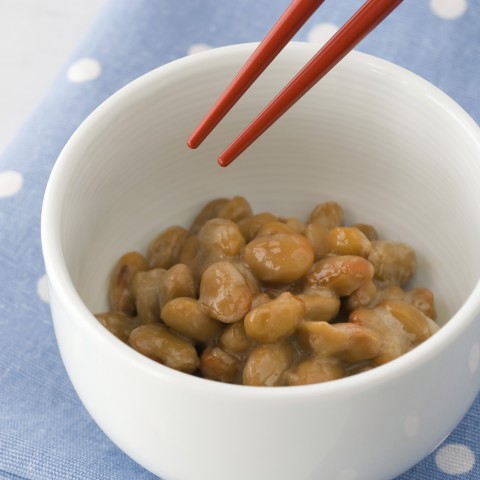
Natto is made of fermented soybeans.
馬刺し (Basashi)
Horse meat is eaten in some regions of Japan. 馬刺し (basashi), or sliced raw horse meat, is especially popular, eaten with grated ginger or garlic, sliced onions, and soy sauce. It’s served at 居酒屋 (Izakaya)-style dining bars.

Raw horse meat tastes similar to beef.
海藻 (Kaisō)
Kaisō, or “seaweed,” is commonly eaten in Japan, usually as an ingredient in みそ汁 (miso) soup or salad. There are several kinds of seaweed, but わかめ (wakame) is one of the most popular types.

Kaisō is often eaten in salad or as a small side dish.
4. Food-Related Japanese Vocabulary
Now that we’ve whetted your appetite, it’s time to look at some Japanese food vocabulary that you can start practicing today!
1 – Ingredients
| English | Kanji | Hiragana | Reading |
| meat | 肉 | にく | niku |
| chicken meat | 鶏肉 | とりにく | toriniku |
| pork | 豚肉 | ぶたにく | butaniku |
| beef | 牛肉 | ぎゅうにく | gyūniku |
| fish | 魚 | さかな | sakana |
| vegetable | 野菜 | やさい | yasai |
| mushroom | – | きのこ | kinoko |
| egg | 卵・玉子 | たまご | tamago |
| milk | 牛乳 | ぎゅうにゅう | gyūnyū |
| rice | ご飯 | ごはん | gohan |
| noodle | 麺 | めん | men |
| soy sauce | 醤油 | しょうゆ | shōyu |
| salt | 塩 | しお | shio |
| sugar | 砂糖 | さとう | satō |
| spices | 香辛料 | こうしんりょう | kōshinryō |
To learn more food-related vocab with audio, please check out our vocabulary lists “Food” and “What’s Your Favorite Japanese Food?“
2 – Cooking Methods
| English | Kanji | Hiragana | Reading |
| deep-fried | 揚げた | あげた | ageta |
| stir-fried /pan-fried | 炒めた | いためた | itameta |
| steamed | 蒸した | むした | mushita |
| boiled | 茹でた | ゆでた | yudeta |
| simmered | 煮た | にた | nita |
| fermented | 発酵した | はっこうした | hakkō shita |
| half-cooked | 半熟の | はんじゅくの | hanjuku no |
| raw | 生の | なまの | nama no |
| matured / aged / ripened | 熟成した | じゅくせいした | jukusei shita |
3 – Phrases for Ordering Food
- メニューをもらえますか。(Menyū o moraemasu ka.) – “Can I have a menu?”
- これはどんな料理ですか。(Kore wa donna ryōri desu ka.) – “What kind of food is this?”
- 私は___を食べられません。(Watashi wa ___ o taberaremasen.) – “I cannot eat ___.”
- 私は___のアレルギーがあります。(Watashi wa ___ no arerugī ga arimasu.) – “I am allergic to ___.”
- これに___は入っていますか。(Kore ni ___ wa haitte imasu ka.) – “Does this have ___ inside?”
- これはどのくらい辛いですか。(Kore wa dono kurai karai desu ka.) – “How hot/spicy is this?”
- おすすめは何ですか。(Osusume wa nan desu ka.) – “What do you recommend?”
- これをお願いします。(Kore o onegai shimasu.) – “I will have this one, please”
For more phrases, see our list of Useful Phrases for Ordering Food and learn useful vocabulary with audio.
5. Easy and Simple Recipes
Before you go, check out these easy recipes for Japanese cuisine to make at home! With only a few ingredients and a little spare time, you can eat delicious Japanese food without needing to find a specialized restaurant.
1 – Okonomiyaki
Okonomiyaki is very simple to make! Basically, all you need to do is mix all of the ingredients together and pan-fry it. Serve with Okonomiyaki sauce and toppings.
For two servings,
Ingredients:
- 100g wheat flour
- 2 eggs, beaten
- 120ml water
- 3 teaspoons spoons dashi powder
- 200g cabbage, sliced and roughly chopped
- your favorite ingredients (e.g. sliced pork meat / seafood mix / cheese / spinach)
- 1 tablespoon vegetable oil
Sauce & toppings:
- Okonomiyaki sauce
- Katsuobushi / Bonito flakes
- Aonori seaweed flakes
- Japanese mayonnaise
Step 1: Mix all ingredients well in a bowl. For sliced pork meat, add in the next step.
Step 2: Put vegetable oil into a small- or middle-sized heated pan. Pour the mixture onto a heated pan and spread it to approximately 2 cm thickness. If you’re using thin-sliced pork meat, place it on the mixture.
Step 3: Fry it until the frying surface is cooked and turns brown. Flip Okonomiyaki over and cook it for about 5 minutes with the lid on.
Step 4: Open the lid and fry it until it’s well-cooked inside. Flip it again to cook as needed.
Step 5: Serve Okonomiyaki with Okonomiyaki sauce, mayonnaise, bonito flakes, and aonori seaweed flakes on top.
2 – Oyakodon
Oyakodon is one of the easiest bowl dishes to make at home. Oyako means “parent and child,” referencing the dish’s ingredients: chicken and egg.
For two servings,
Ingredients:
- 400g cooked white rice (Japanese rice)
- 1 small onion, cut in half and thin-sliced
- 200g chicken thighs, cut into bite-size pieces
- 2 eggs, beaten
- 1 tablespoon vegetable oil
Condiments:
- 2 tablespoons soy sauce
- 2 tablespoons cooking sake (or white wine)
- 2 tablespoons mirin
- 1 tablespoon sugar
- 2 teaspoons dashi powder
Step 1: Pour vegetable oil into a pan on middle heat. Stir fry the chicken meat until it changes color.
Step 2: Add onions and cook until they become soft and then pour all the condiments into a pan.
Step 3: Simmer until liquid is evaporated to about half the original amount, and then pour ⅔ of the beaten eggs.
Step 4: When eggs are cooked, add the rest of the beaten eggs and cook it for around 10-15 seconds.
Step 5: Put it on the warm white rice in a donburi / bowl and serve. If you have nori/seaweed paper, sprinkle it on the top.
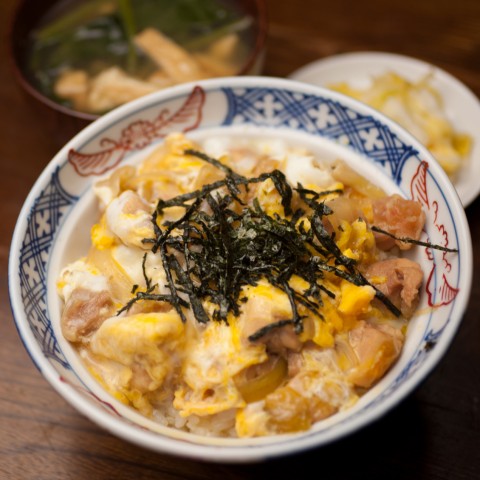
6. How JapanesePod101 Can Help You Learn More Japanese
In this article, we introduced several Japanese foods that you must try, including those you should only eat in Japan and others to make at home. We also provided you with some useful food-related vocabulary for cooking and ordering. I hope you enjoyed this article and that you’ve become more interested in such a fascinating cuisine!
If you would like to learn more about the Japanese language and culture, you’ll find more helpful content on JapanesePod101.com. We provide a variety of free lessons to help you improve your Japanese language skills. If you’re just starting out, here are a few vocabulary lists we recommend you review:
Personal one-on-one tutoring is also available through our MyTeacher service when you upgrade to Premium PLUS. Your private teacher will help you practice pronunciation and you’ll get personalized feedback and advice to improve efficiently.
And there’s so much more we have to offer you! Learn faster and enjoy studying Japanese at JapanesePod101.com!
Before you go, let us know in the comments what you learned about Japanese food today. How many of these dishes have you tried before? We look forward to hearing from you.










